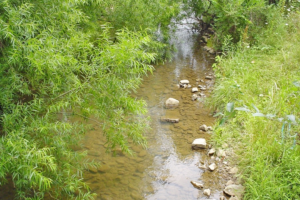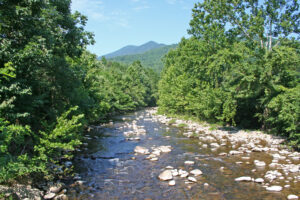People need access to clean, plentiful drinking water. As populations increase across the Commonwealth, public utilities must find ways to meet the growing demand for water. Almost half of Virginia’s surface drinking water comes from state and private forestlands within the Commonwealth. To protect our drinking supply long into the future, we need to conserve forests.
Public drinking water sources include rivers, streams, lakes, reservoirs, springs and groundwater. But before it makes its way to your faucet, utilities need to first ensure the water is safe and drinkable to protect public health. This can mean investing in infrastructure to filter and treat water. Or it can mean investing in nature’s best, cheapest water purification system – FORESTS.
When municipalities invest in protecting forested watersheds, they take advantage of the natural, essential processes of forests that result in clean water. Runoff from impervious surfaces, such as pavement and rooftops, travels quickly and carries along pollutants. The fast-moving water and pollutants can degrade our water quality. Trees and forests filter out many of those pollutants and contaminants by slowing down the runoff, allowing the pollutants to settle out of the water as it moves over the forest floor. They also reduce the volume of run-off by allowing more time for the water to infiltrate the soil. Once in the soil, the water may be used by the trees or refill aquifers.
Trees also help to prevent sediment from entering bodies of water by holding the soil in place with their roots. Their roots anchor soil which minimizes erosion and sedimentation.

Trees process water and pollutants into basic elements for growth.
For decades, technology has supplemented the natural services provided by forests, but at a high price. Significant funds are dedicated to constructing and upgrading water treatment plants to clean public water supplies degraded by pollution. Those funds can instead be invested in conserving watersheds and protecting our water sources from pollution.
There are numerous state and federal programs that support source water protection, such as the Environmental Protection Agency’s (EPA) Clean Water Act and Safe Drinking Water Act, and the Virginia Department of Health’s (VDH) Source Water Protection Program.
Municipalities may decide to protect their water sources in a number of ways, such as conservation easements on critical lands or waters ordinances and zoning codes for protecting watersheds. Local government officials are often faced with tough decisions between supporting environmental protection and economic development, however, preserving forestland can be a win-win. The financial value becomes clear when the costs of protecting an ecosystem for improved water quality are compared with investments in new or improved water treatment facilities.
More than 80% of forestland in Virginia is privately owned. Municipalities rely heavily on these private landowners to protect watersheds since healthy well-managed forests are essential to Virginia’s drinking water. DOF works with landowners and loggers to protect watersheds for all Virginians.
Learn more about how forests protect water.
How You Can Help
If you’re a landowner, conserve and manage your forestland to protect water sources.
- Leave streamside management zones when harvesting.
- Establish riparian forest buffers.
If you’re not a forest landowner, you can still help protect your drinking water supply.
- Minimize your use of lawn fertilizers and always dispose of chemicals properly to prevent them from polluting waterways.
- Replace turfed lawn and paved areas with native plants and woody vegetation. Learn about rain gardens.
- Join watershed groups for tree planting and stream cleanups.
Learn more about why healthy forests are critical to the future of our drinking water.



